A walk in tub eliminates the safety hazard inherent in traditional bathtubs by eliminating the need to step over the side.
Many walk in tubs are ADA compliant, provide comfortable seating, and feature water jets that massage muscles and relieve the aches and pains of arthritis.
Walk in tubs are typically enjoyed by seniors. But they’ll appeal to anyone who needs to soak sore muscles after a workout, or wants to pamper themselves at the end of a long day. Below are the best walk in tubs for 2023.
Rankings
1. Empava 52.5 in. Acrylic Walk-in Tub
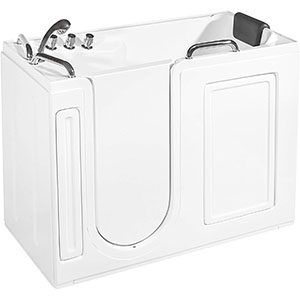
Click here for the lowest price on Amazon
We start our list with this outstanding, affordable, soaking tub from Empava. It holds nearly 100 gallons of water and has lots of sturdy, smartly-positioned handles. It’s a great choice for those who like to light a few candles and just relax. Designed and made in the USA.
What we like: We like the clean lines and solid feel of this tub. We appreciate the extra-large capacity (94 gallons). We appreciate how easy it is to get in and out. And we like that all necessary holes are pre-drilled and ready to go. Which means a reasonably capable DIYer can likely install it.
Flaws: This is a soaker tub, which means there are no water jets.
2. American Standard Right Hand Walk in Tub

Click here for the lowest price on Amazon
This walk in from American Standard is a step up feature-wise from the Empava. It’s also a couple of steps up price-wise. But if the idea of a wheelchair-friendly walk in tub with plenty of high-powered water jets that drains fast is what you’ve been looking for, here it is.
What we like: At 16 gallons per minute, we appreciate how fast this tub fills. We like the big door. And the water jets provide first-class hydrotherapy for arthritis sufferers. The 10-year warranty is nice to have too.
Flaws: It’s not the cheapest walk in tub on the market. And for the price, another safety rail would have been nice.
3. Ella Deluxe Acrylic Walk in Bathtub
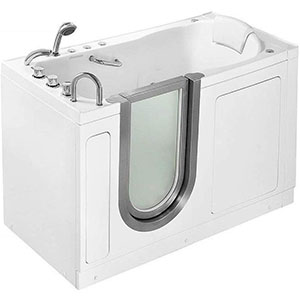
Click here for the lowest price on Amazon
With its stainless steel and frosted glass door, the Ella Deluxe Acrylic Walk in Bathtub has a distinctive, high-end look to it. Overall, it’s impeccably built, has a scratch-resistant surface, and the 10 water jets pile on the relaxation.
What we like: One of the best hydrotherapy tubs going. The textured floor does a great job providing sure footing. And the contoured seat helps prevent slipping and sliding. The pair of 2 inch drains also ensures it empties fast once you’re ready to go.
Flaws: There are other walk in tubs that fill faster. And that brushed stainless steel door frame looks good but is cold on frosty winter days.
4. Ariel EZWT-3048 Walk in Bathtub
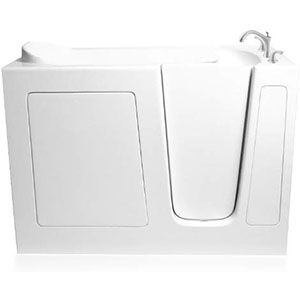
Click here for the lowest price on Amazon
The extremely clean lines and subdued profile of the Ariel EZWT-3048 will dovetail nicely with just about any modernist bathroom. Inside the tub provides a comfy seat, and it stacks the water as high as any other tub on our list. It’s a great tub for relieving muscle aches, arthritis pain, or unwinding at the end of the day.
What we like: While the Ariel is a little smaller than some other tubs, it’s also higher, so you get a more complete soak. We like that the seat is surprisingly comfortable. And that the tub is ADA compliant. It also fills pretty fast, and the jets do a good job moving the water around.
Flaws: ADA compliant or not, we want to see more safety rails along the top.
5. Aqua Acrylic Walk In Tub
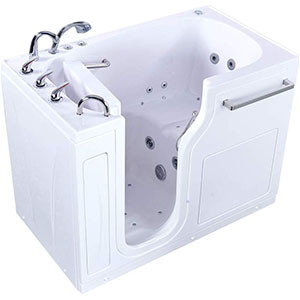
Click here for the lowest price on Amazon
The Aqua Acrylic Walk in Tub covers all the bases. It’s remarkably compact, so even if your bathroom is small, there’s a good chance you can fit it in without having to make any structural changes.
What we like: We like that you can choose to have a heated seat. We like the strong, well-positioned grab bars, and we appreciate how easy it is to level this thing using the nine adjustable legs. We were also impressed that it drains in about a minute and a half.
Flaws: The fact that the door opens inward makes it more difficult to use if you’re in a wheelchair.
6. Anzzi Right Drain Walk-In Tub
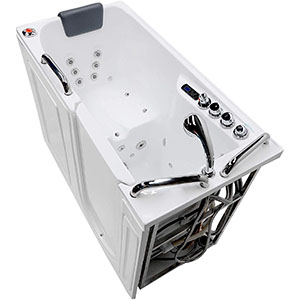
Click here for the lowest price on Amazon
If you’re into the whirlpool type of experience, the Anzzi Walk in Tub is beckoning. This tub will cost you a bit more than some others. But if you suffer from arthritis or just have a hard time getting to sleep at night, you’re going to think it’s money well spent.
What we like: We appreciate that Anzzi pulls out all the stops. It features water jets for hydrotherapy, air jets for aromatherapy, and internal lighting for chromatherapy. It also boasts plenty of safety rails and a head rest so you can kick back and relax.
Flaws: It’s heavy, so make sure you have someone there to help when it arrives.
7. Spa World Venzi Vz3060 Soaking Walk-In Bathtub
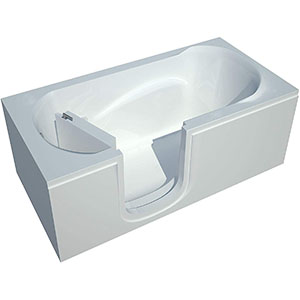
Click here for the lowest price on Amazon
The Spa World Venzi looks simple because it is. But it’s also practical, affordable, compact, and stylish. So, if you are tired of taking your life in your hands getting in and out of your standard tub, you now have a viable option.
What we like: First off we appreciate the affordable nature of this tub. It’s also well-built and will likely stand the test of time. It fills fast, drains fast, and doesn’t take up lots of space.
Flaws: Don’t look for water or air jets. Or a seat for that matter. This is a minimalist walk in tub for those not suffering any particular limitation.
8. Mecor Walk-in Whirlpool Bathtub
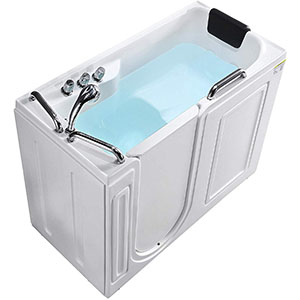
Click here for the lowest price on Amazon
This is a slightly stripped-down version of the Anzzi we profiled above. Basically, what it’s missing are the water jets. But if you’re the kind who just likes to sink into a warm bath and soak you’ll love this tub. It’s handsome, durable, easy to install, and relatively affordable.
What we like: Strong, well-positioned safety rails. A 20-inch wide seat with padded headrest. Tall sides that let you enjoy a full-body soak. And the slip-resistant floor is very effective at grabbing the bottom of your feet.
Flaws: There are no water or air jets, so don’t bother looking. Also, the door opens inward, so if you’re confined to a wheelchair, this is not the tub for you.
9. Mecor Low Walk-in Bathtub
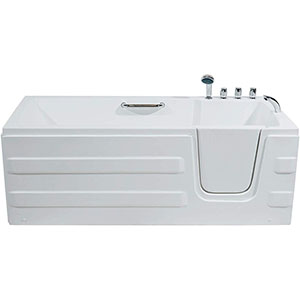
Click here for the lowest price on Amazon
This is the second of our low-rise walk in tubs. Again, you won’t want to install this in your grandmother’s house. The door here, for instance, is more a convenience than something intended to aid those with mobility issues. And that’s alright. Younger folks have a right to enjoy a good, safe soak too.
What we like: A great tub for the athletically inclined who appreciate a good soak. For what it is, it’s a good value. And with the affordable price point and 10-year warranty on workmanship, you don’t have much to lose.
Flaws: There’s no seat. The sides are about the height of a standard tub. And there are no water or air jets. Strictly a soaker tub.
10. CleanCut Step Bathtub Accessibility Kit
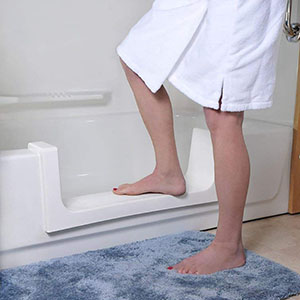
Click here for the lowest price on Amazon
Replacing a tub with a shower has historically been an expensive, time-consuming affair. But if you have a fiberglass tub you’re in luck. The CleanCut will enable you to transform your current tub setup into a walk in shower in just a few hours and for very short money.
What we like: We appreciate that the instructions are clear and easy to follow. We like that it can be installed in a single Saturday afternoon. And we like how low the step is, making it attractive to young and old.
Flaws: If you’re not a talented DIYer, you’re going to need help. Plus, you’re on your own when it comes to installing handrails.
Who Needs Walk In Tubs?
The bathroom presents an array of hazards. And not just for older folks (1). The CDC estimates that more than 600 people each day are injured in bathroom accidents in the US alone. Of course, for older folks, the looming hazards are even more dangerous. First, because they are often dealing with conditions that interfere with free movement and second, because if they injure themselves, the recovery time is so much longer.
One of the most troublesome bathroom hazards is stepping in and out of the bathtub. But simply replacing the tub with a shower stall doesn’t really alleviate the problem. It just alters the details. Instead of slipping on the floor as you try and step over the side of the tub, you slip on the floor as you move in the shower. Walk in tubs eliminate – many of which are ADA compliant (2) – this risk altogether. All you do is open the door, step into the tub area, sit down, close the door, and turn on the water. No awkward stances. Minimal risk of slipping.
How We Ranked
There are a surprising number of different brands and styles of walk in tubs on the market. But, as with everything else, some are worth the investment, and some are not. And it is an investment. Walk in tubs are not cheap. Still, if they prevent you from having a life-changing injury, then they are worth every penny in the long run.
The first thing we want to see in any walk in tub is as low a step as possible. Because the only way to make the bottom of the tub level with the floor would be to recess the tub a bit. And that would be quite the construction project. So we have to accept some degree of step up. Most experts consider a 2.5 – 5-inch step acceptable. Any more is too much for some older folks.
We also want to see plenty of nice, sturdy handrails to hold onto. The more, the better. Not everyone will need them. But really, even if you’re 25 and using this type of tub to alleviate your sore muscles after a long run, you don’t want to injure yourself. So handrails/safety handles are alright with us. We also insist the door seals up nice and tight. Believe it or not, there are some out there that don’t. Those tubs did not make our list.
The exact size isn’t as important as whether it provides a nice comfortable seat and enough room to stretch out your legs and relax. It’s also a plus if the tub sits neatly into the space where your old tub used to be. The depth of the water is also important. Whereas water in a standard tub usually tops out at about a foot deep, we want to see a walk in tub double that. More than double it if possible.
Finally, we also look for therapeutic jets like you get in a hot tub. They can be of immense benefit for folks with arthritis. So the more jets, and the more different kinds, the better. In most cases. But because we also understand that not everyone is a fan of the water jet, we included a couple of tubs that don’t have them.
FAQs
Q: What is a walk in tub?
A: A walk in tub is a bathtub with unusually tall sides and a door in the side. Most also have an integrated seat inside, which is the reason the sides are higher than normal (so that the water can come up high enough to cover most of the person as they sit). The design enables a person to enter and exit the tub without having to engage in the potentially risky business of stepping over the side. Many also have water jet features that provide beneficial massage-style effects that help alleviate joint stiffness and muscle aches.
Q: Are there different kinds of walk in tubs?
A: There are a number of different walk in tubs on the market today. The simplest designs are intended just for soaking, like a standard tub. Tubs that use air jets are designed for aromatherapy. Those that use water jets are intended for hydrotherapy, and some use various lighting features to create a more relaxing mood. Those tubs are said to offer ‘chromatherapy’.
Q: Are walk in tubs good for arthritis?
A: Yes. With their high sides and deeper basins, walk in tubs are an outstanding way to enjoy relief from the pain and stiffness of arthritis. Researchers have long been aware of the therapeutic value of applying heat to relieve the symptoms of arthritis (3). And a nice warm bath is among the most effective ways to engage in this type of therapy.
Q: How much do walk in tubs cost?
A: We’re not going to sugarcoat it; walk in tubs can be expensive. There are several reasons for this. First of all, because they’re bigger than standard tubs, it takes more material to make them. Second, they often have built-in features like safety railings that cost extra to produce. And of course, engineering and building the waterproof door costs money as well. Add all these things up, and you have a tub that costs more than most standard tubs.
Q: Is a walk in tub easy to install?
A: A senior citizen living alone or an elderly couple are going to need help installing their walk in tub. If you are a reasonably capable do-it-yourselfer, however, you’ll likely be able to install the tub yourself. However, if there is more than the most rudimentary plumbing and electrical work involved, you should hire professional help regardless. That’s because it doesn’t take much of a plumbing or electrical mistake to generate serious consequences.
Q: Will Medicaid cover the cost of my walk in tub?
A: Unfortunately, Medicaid does not cover the cost of a walk in tub because it’s not considered to be an absolute necessity. And that’s the case even if your doctor recommended a walk in tub to help you deal with arthritis or any other condition. It’s possible you may be able to deduct some of the cost of the tub from your taxes. If you have that all-important doctor’s note supporting the notion that it’s medically necessary, but don’t hold your breath. Your chances are about 50-50.
Q: Are walk in tubs wheelchair accessible?
A: Some are and some aren’t. Certainly, if you need a wheelchair accessible walk in tub, there are plenty on the market. If you are unsure whether a tub is wheelchair accessible, look for things like the height of the seat and the direction the door opens. On a wheelchair accessible tub, the seat should be a little lower than normal to facilitate a smooth transfer from chair to seat. And the door should open outward so that it doesn’t interfere with that chair to seat and seat to wheelchair transfer.
Q: Do all walk in tubs have jets?
A: Most do, but jets are not a prerequisite for a walk in tub. Still, if you are going to invest in one, it doesn’t make sense not to avail yourself of some water or air jets. Simply because there is bound to come a time when you will want them. There may also come a time when you need them to help you recover from an illness or injury. Just remember, there are two types of jets. Those used to enable aromatherapy and those that produce a soothing massage-like effect.
Q: How much space does a walk in tub require?
A: Most walk in tubs are designed to fit into the footprint of a standard tub. And while you can certainly get them bigger than that if you want, you may have to make alterations to your bathroom to enable the larger tub to fit. Remember, too, that walk in tubs typically hold more water than a standard tub does. So the floor needs to be structurally sound and fully capable of supporting any extra weight.
Q: Are there any disadvantages to walk in tubs?
A: Walk in tubs can take a while to fill. Why is that an issue? Because, unlike a standard tub, you have to get into the walk in tub before you turn on the water. That’s because of the door. Still, all the tubs we chose for our list fill pretty fast. And once you experience the tub in all its glory, you’re likely to forget how long it took to fill. If you’re worried about getting cold while you wait for the tub to fill, there are some available with heated seats.
Q: Do they make walk in tubs for larger individuals?
A: They do. They’re called ‘bariatric’ tubs, and they can accommodate just about anyone. A regular walk in tub usually has a weight limit of around 300 pounds. A bariatric tub, by comparison, may accommodate twice that much or more.
Q: How much water do walk in tubs use?
A: Whereas a standard tub will hold 30 to 40 gallons (give or take), a walk in tub may hold as much as 75 or 80 gallons. As a gallon of water weighs a little over 9 pounds, that 40 extra gallons is going to add 360+ pounds to the tub when it’s full. This is why we mentioned that if your home is on the old side, it might be worth having an engineer look at the bathroom to make sure it can accommodate the extra weight.
Q: What does it mean if a walk in tub is ‘ADA’ compliant?
A: ADA stands for the ‘Americans with Disabilities Act’. The ADA sets design standards for a plethora of products needed by the disabled to facilitate their life and maintain their health. As far as a walk in tub is concerned the ADA specifies the location of the controls, the height of the seat, the placement of the safety rails and more (4). Any tub that signifies it is ADA compliant must adhere to the standards established by the ADA. No exceptions.
Related Articles
Recap
A walk in tub can make a world of difference in a senior citizen’s quality of life. It can help them deal with maladies like arthritis, enable them to maintain their independence, prevent them from sustaining a life-changing injury, and just provide them a way to relax and get to sleep.
Walk in tubs are also useful for younger adults. They can help you recover faster from a tough workout, recover from soft tissue injuries and provide a way to decompress at the end of a long, tough day at work.
For cpoe.org’s #1 recommended walk in tub, click here.

